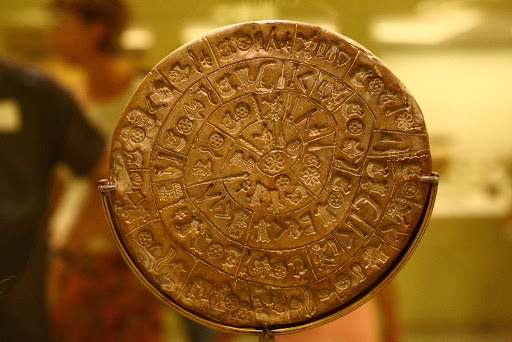Posted on 06/25/2009 3:16:34 PM PDT by SunkenCiv
Since this disk was found in Crete, and the people of Crete today speak Greek, that's a good language to assume was spoken by the maker of the disk. Still, that's a guess, or a hypothesis, not a fact. Besides that, we know that not everybody on Crete spoke Greek in the Bronze Age. The classical Greeks mentioned people they called Eteocretans who did not speak Greek. Further, we know that Linear A, written by the Minoans on Crete before the Mycenean Greeks came, did not represent Greek. Professor Hubert LaMarle considers it to be an early Indo-Iranian language, related to Old Persian and Sanskrit. So it's also possible that the Phaistos disk does not contain Greek, but this Indo-Iranian language.
Then again, as Jan Best and Fred Woudhuizen point out (in Lost Languages from the Mediterranean, 1989, Leiden, E.J. Brill), the Cretans were in contact with the west coast of Asia Minor, where Luwian was spoken, so it's also possible that the disk was written in Luwian, or even Hittite. The Cretans also had contact with people on Cyprus, on the coasts of Canaan, and even with Egypt. How can anyone say for certain that it is not one of these languages? The fact that more people hypothesize it's Greek than any other language isn't proof that it's Greek. That may simply prove that the Grecophiles are more likely to try deciphering the disk than the Hittitophiles (who may be preoccupied with puzzling over Hurrian or Hattic bilinguals).
(Excerpt) Read more at examiner.com ...
|
|
|||
Gods |
Another column installment about the Phaistos Disk by the same author as last week's, a very fun review of a review of a review of a book purporting to be a translation. |
||
|
· Discover · Nat Geographic · Texas AM Anthro News · Yahoo Anthro & Archaeo · Google · · The Archaeology Channel · Excerpt, or Link only? · cgk's list of ping lists · |
|||
What is this doohicky?

Probably just some prehistoric elementary school kid messing around in arts and crafts class.
We have this area rug with similar figures and shapes on it.
If I stare at it long enough, will I learn the truth?
Thanks, is that one of the TinyPic ones? They looked excellent in thumbnail. Now I wanna spend the next six months cruising Euro- and Med- museums and arch sites. Not that I don’t *usually*...
The Phaistos Disk inspired your rug, and though it’s not generally known, also was the model for that audio recording attached to the deep space probes NASA launched in the 1970s — hence the title of that book, “Berbers of Earth”.
[long pause, crickets chirping]
LOL! I stepped right into that one.
Technically, you stepped *onto* it. ;’)
Si!
It’s a unique artifact excavated in Crete, from a pre-Classical stratum. It was made with dies, basically analogous to movable type, then fired to hardness. Nothing like it has (yet) been found in any other site, and the characters used are unique (but resemble character sets found in some Anatolian inscriptions). We’ve had a topic about this artifact having been made in modern times as a forgery and salted into the dig, as had been suggested by a few before. Consensus is, it’s a legitimate ancient artifact containing an unknown inscription. The authority in charge of it will not permit thermoluminescence dating to be performed, even though that would settle the question, due to its uniqueness. Probably it could be examined in some other noninvasive way, but I’m not too sure I’ve ever seen one suggested. Probably a small sample (or a series of very tiny ones from different spots on the disk, combined) could be analyzed to determine geographic origin, but I’m not too sure of that one either. :’)
Popular Archaeology had some ridiculous new article, claiming that this is civilization is newly discovered, and proves again how Eurocentric historical research is. That’s just pure bull****, and probably related to the current full-court-press to shove Turkey into the EU. Nice to know about this website, anyway:
[snip] The foundation Luwian Studies today announced the go-live of its website in English and German as well as the publication of a book entitled “The Luwian Civilization — The Missing Link in the Aegean Bronze Age”. The book contains virtually all the texts and most of the illustrations that make up the English version of the website. People who are interested in the Middle and Bronze Age in western Asia Minor now have the choice to read up on it either online or in the form of a book. The book is authored by Eberhard Zangger and published by Ege Yayinlari, Istanbul. It contains 292 pages and 148 color illustrations and is available as of now (ISBN 978-605-9680-11-0). [/snip]
http://luwianstudies.org/book-publication-appears-luwian-civilization/
Disclaimer: Opinions posted on Free Republic are those of the individual posters and do not necessarily represent the opinion of Free Republic or its management. All materials posted herein are protected by copyright law and the exemption for fair use of copyrighted works.